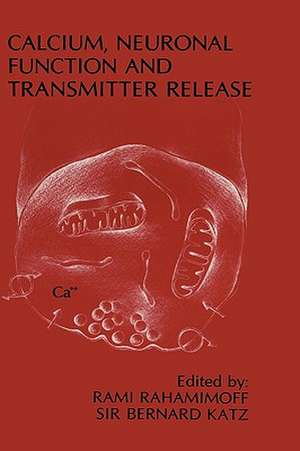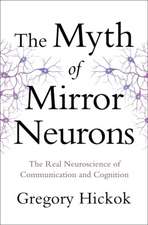Calcium, Neuronal Function and Transmitter Release: Proceedings of the Symposium on Calcium, Neuronal Function and Transmitter Release held at the International Congress of Physiology Jerusalem, Israel—August 28–31, 1984: Topics in the Neurosciences, cartea 1
Editat de Rami Rahamimoff, Bernard Katzen Limba Engleză Hardback – 31 mar 1986
| Toate formatele și edițiile | Preț | Express |
|---|---|---|
| Paperback (1) | 1233.20 lei 6-8 săpt. | |
| Springer Us – 21 sep 2011 | 1233.20 lei 6-8 săpt. | |
| Hardback (1) | 1239.49 lei 6-8 săpt. | |
| Springer Us – 31 mar 1986 | 1239.49 lei 6-8 săpt. |
Preț: 1239.49 lei
Preț vechi: 1511.58 lei
-18% Nou
Puncte Express: 1859
Preț estimativ în valută:
237.21€ • 245.77$ • 197.97£
237.21€ • 245.77$ • 197.97£
Carte tipărită la comandă
Livrare economică 21 martie-04 aprilie
Preluare comenzi: 021 569.72.76
Specificații
ISBN-13: 9780898387919
ISBN-10: 0898387914
Pagini: 612
Ilustrații: XXVIII, 612 p.
Dimensiuni: 155 x 235 x 35 mm
Greutate: 1.07 kg
Ediția:1986
Editura: Springer Us
Colecția Springer
Seria Topics in the Neurosciences
Locul publicării:New York, NY, United States
ISBN-10: 0898387914
Pagini: 612
Ilustrații: XXVIII, 612 p.
Dimensiuni: 155 x 235 x 35 mm
Greutate: 1.07 kg
Ediția:1986
Editura: Springer Us
Colecția Springer
Seria Topics in the Neurosciences
Locul publicării:New York, NY, United States
Public țintă
ResearchCuprins
Section 1 Calcium Channels, Transporters & Calcium Regulated Channels.- Effects of Temperature on Single Channel and Whole Cell Ca Currents.- A Channel View at Ca Inactivation.- Modulation Of Calcium Channels In Cardiac Cells By Neurotransmitters.- Some Properties of Calcium Current in Mouse Motor Endings.- Molecular Properties of Isolated Ca2+ Transport Systems from Nerve Terminals.- Calcium-Activated Potassium Channels in Presynaptic Nerve Terminals.- Histamine as a Putative Transmitter of Presynaptic Inhibition: Effect onto the Ca Channel in Aplysia Neurons.- Persistent Inactivation of Potassium Currents by Elevation of Intracellular Calcium.- Section 2 Calcium & Transmitter Release.- Some Consequences of Intracellular Calcium Binding on Phasic Synaptic Transmitter Release.- Calcium Cooperativity in Calcium Entry and Calcium Action, and its Implications with Regard to Facilitation, at the Mouse Motor Nerve Terminal.- Resting Calcium Levels and Evoked Release at the Neuromuscular Junction.- Serendiptic Modulation of Transmitter Release: Extracellular Calcium Inhomogeneity.- Calcium Independent Quantal Transmitter Release at the Neuromuscular Junction.- On The Voltage Dependence of Neurotransmitter Release.- A Possible Involvement of the Na-Ca Exchanger in Regulation of Transmitter Release at the Frog Neuromuscular Junction.- Section 3 Calcium & Exocytosis.- Optical Studies of Excitation and Secretion in Vertebrate Nerve Terminals.- Physiological Bases for Differing Synaptic Efficacy in Frog Neuromuscular Junctions.- Neurotransmitter Release from Pc12 Cells.- Sub-Mepps, Skew-Mepps and the Subunit Hypothesis of Quantal Transmitter Release At The Neuromuscular Junction.- Frequency of Miniature End Plate Potentials Determined by an Extension of Campbell’s Theorem.-Markers for Membrane Components to Study “Recycling” at Neuromuscular Junctions.- The Role of Calcium In Triggering the Release of Transmitter at the Vertebrate Neuromuscular Junction. an Analysis of the Effects of Drugs.- Modulation of Presynaptic Transmitter Release by ATP Derived from Postsynaptic Sources.- Regulation of Voltage-Sensitive Calcium Channels in Brain by Micromolar Affinity Benzodiazepine Receptors.- Section 4 Calcium Dependent Mechanisms.- The Mechanism of Bursting in Aplysia Pacemaker Neurons.- A Parametric Study of the Neuromuscular Junction During Ontogenesis and Under Different External Conditions.- Phenytoin, Transmitter Release and Calcium Flux.- Currents in the Synaptic Terminals of Barnacle Photoreceptors.- Calcium Channels Formation and Modulation in Secreting Basophils and Mast Cells.- Initial Characterization of the Calcium Channel Activated by the Crosslinking of the Receptors for Immunoglobulin E*.- Sequence of Development of Ionic Channels During Mouse Neuronal Differentiation: a Patch-Clamp Study.- Free Communications.- Calcium Currents and Potassium Conductance Changes Explain Low-Dose Sedative Drug Actions in Mammalian Hippocampal Neurons.- Interaction Between Corticosteroids and Presynaptic-Acting Toxins From Snake Venoms in Rat Phrenic Nerve Terminals.- Fluctuation Analysis Applied to Nonstationary Biological Processes.- Calcium Independent Depletion of Quanta and Synaptic Vesicles Induced by Ouabain.- Calmodulin Inhibitors and Transmitter Release at the Frog Neuromuscular Junction.- Studies on the Mechanism of the Inhibitory Action of Verapamil on Ca2+ Transport.- Manganese and Asynchronous Transmitter Release at the Frog Neuromuscular Junction.- Several Potassium Conductances Modulate the Excitability of Frog Motor NerveTerminals.- Electrophysiological Examination of Glucose Transport into Motor Nerve Terminals in Mature Adult and Aged Rats.- The Asymmetry of Glucose Transport in Nerve Terminals; Possible Role in the Etiology of Diabetic Neuropathy.- The Role of Peptides Released by Small Cell Carcinoma of the Lung on Neuromuscular Transmission: Calcitonin.- Biphasic Effect of Calcium on Tetanic Potentiation at the Frog Neuromuscular Junction.


















